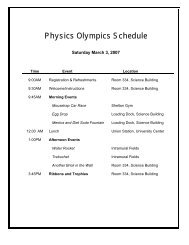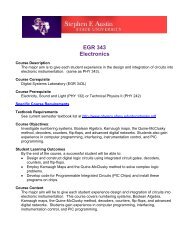Program - Physics & Astronomy - Stephen F. Austin State University
Program - Physics & Astronomy - Stephen F. Austin State University
Program - Physics & Astronomy - Stephen F. Austin State University
You also want an ePaper? Increase the reach of your titles
YUMPU automatically turns print PDFs into web optimized ePapers that Google loves.
Brownsville. One of the outreach activities, the <strong>Physics</strong> Circus,is expanding this year with the support of the American PhysicalSociety - <strong>Physics</strong> on the Road <strong>Program</strong> to reach limitedexperience students along the lower U.S. Mexico border.2:30 pm - AAPT-6 - What Middle and High School StudentsPerceive <strong>Physics</strong> to be, Manuela Ortiz, Eric Hagedorn,<strong>University</strong> of Texas at El Paso, ehagedorn@utep.edu. In order toincrease the number of students prepared for and willing to takephysics in high school, we have been investigating theperceptions of pre-physics high school and middle school aboutwhat they believe physics to be. Fifty-eight middle schoolstudents and 130 high school students responded to the prompt:“Briefly write what you think physics is about.” Responses weresorted and coded using the TextSmart software package.Percentages for the various categories are provided as well asinterpretation, theoretical explanations and possible educationalimplications.3:06 pm - AAPT-7 - A Pre-service Teacher Preparation<strong>Program</strong> for Middle School Science, Thomas O. Callaway;John Moore, <strong>Stephen</strong> F. <strong>Austin</strong> <strong>State</strong> <strong>University</strong>,tcallaway@sfasu.edu. The College of Sciences and Mathematicsat <strong>Stephen</strong> F. <strong>Austin</strong> has developed a successful undergraduateprogram to train middle school science teachers. Thispresentation will describe the process that our team has utilizedin order to provide an effective instructional program thatprovides both content and “hands-on” experience in science. Wewill include in our discussion our strategy for preparing studentsto meet the Texas state standards and assessment for middleschool science teaching.3:18 pm - AAPT-8 - It's About Time: Relativity and MarkTwain's "My Watch", Hugh Henderson, Plano Senior HighSchool, hhender@pisd.edu. Around 1870, over three decadesbefore Einstein's annis mirabilis, Mark Twain wrote a humorousessay entitled "My Watch," which makes an excellentspringboard for introducing students to relativity. This talk isbased on my article which will appear in The <strong>Physics</strong> Teacherlater this year.3:30 pm - AAPT-9 - Building Telescopes with anUndergraduate Class, David Craig, West Texas A & M<strong>University</strong>, dcraig@mail.wtamu.edu. In 2004, 8 smallDobsonian telescopes were constructed with an undergraduateastronomy class at Delta <strong>State</strong> <strong>University</strong>. A combination andmodification of two readily available sets of online telescopeplans were used. Information on the construction and use ofthese telescopes with a class will be presented, along withsuggestions for anyone wishing to implement a similar project.3:42 pm - AAPT-10 - Use of a Remote Observatory in Survey<strong>Astronomy</strong> Laboratories, Mike Fanelli, <strong>University</strong> of NorthTexas, fanelli@unt.edu. The <strong>University</strong> of North Texas (UNT) isdeveloping an automated off-campus observatory for use in ourlarge survey astronomy courses. The UNT Monroe Observatoryis located at a dark site near the Texas - Oklahoma border, 45miles from campus. It contains four, independently-controlledobserving stations, each with a 14-16 inch telescope positionedby a Paramount ME robotic telescope mount, attached to a pierassembly designed in-house. The telescopes are equipped with28an Apogee Instruments CCD camera, an automated filter wheeland auto-focuser. Guiding is accomplished off-axis using a 4”co-aligned telescope with a separate CCD camera. Toaccommodate multiple telescopes, we chose a roll-off roofdesign for the enclosure. For remote operation, wecommissioned a roof control system, operated using a standardPC under visual basic. Each telescope is operated using twodedicated PCs; communication is via a T1 line, which allows thecontrol computers to appear as if they are connected to thecampus network. Imagery from these telescopes will provide thecenterpiece to an integrated astronomy laboratory curriculum,including digital image analysis, multimedia planetarium labs,direct observations of the sky, and PC-based (CLEA) labs. Thisremote observatory will permit large numbers of students,majoring in disciplines other than the natural sciences, toconduct individualized experiments in a manner parallel to thoseemployed in astronomical research. Graduate students operatethe telescopes from campus, providing a diverse set of imagesfor the survey astronomy students to access via a Web-interface.We will elaborate on the status of the facility, ideas forimplementing digital images into the lab curriculum, and plansfor public outreach. The UNT Observatory has been funded inpart through the National Science Foundation's CCLI grantprogram, #9950630, and the <strong>University</strong> of North Texas.3:54 pm - AAPT-11 - Gender Differences in Teachers'Representations of Electric Circuits, Jill Marshall, <strong>University</strong>of Texas, Science & Math Ed., marshall@mail.utexas.edu. Forthis study I examined the ways in which pre-service and inserviceteachers in a <strong>Physics</strong> by Inquiry class representedelectrical circuits with drawings. Preliminary findings indicatedifferences in the way male and female students representcircuits that cannot be immediately attributed to differences inexperience with formal circuit diagrams. Further, some studentsappear to encode information in their drawings in ways that areat variance with unstated but accepted coding schemes forstandard circuit diagrams. These findings may have implicationsfor equitable instruction.4:06 pm - AAPT-12 - Science Wall: A portable stereoscopicprojection system for education and outreach, Phillip Dukes,Adrienne Rodriguez-Zermeno, <strong>University</strong> of Texas atBrownsville and Texas Southmost College, pdukes@utb.edu. Wewill demonstrate and describe a portable low-cost stereoscopicprojection system being used for general science education andoutreach in the Brownsville, TX area. Our system is anadaptation of a passive 3D GeoWall using polarized light.Examples from planetary science and astronomy will bedemonstrated.4:18 pm - AAPT-13 - Evaluating the Use of Physlets in theLaboratory, Adrienne Rodriguez-Zermeno, Phillip Dukes,<strong>University</strong> of Texas at Brownsville, arodriguez@utb.edu. Thispresentation will cover research done in the algebra-basedintroductory physics laboratory. In one of the laboratory sectionsseveral traditional laboratory exercises were replaced withPhyslet-based labs. Student's performance on pre/post testassessment on these concepts was compared. This research is anextension of the research done by Anne J. Cox at Echerd Collegeapplying it to an open enrollment Hispanic serving institution.



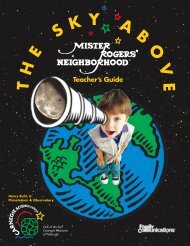
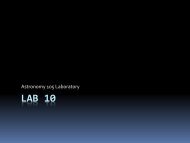
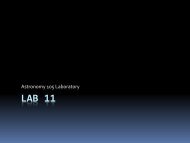
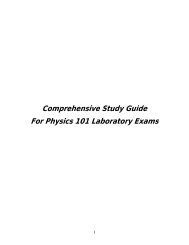

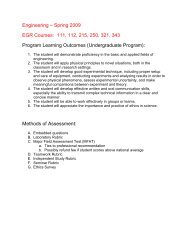
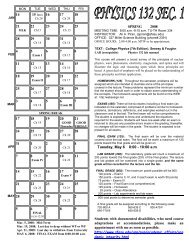
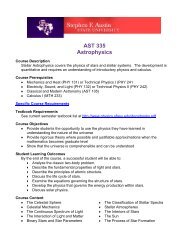

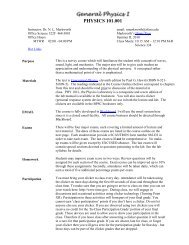
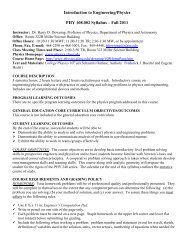
![[pdf] physics 110 fundamentals of electronics](https://img.yumpu.com/29312006/1/190x245/pdf-physics-110-fundamentals-of-electronics.jpg?quality=85)
